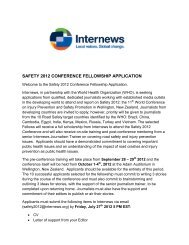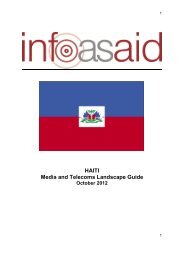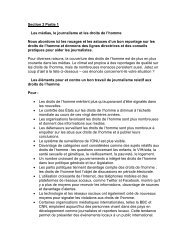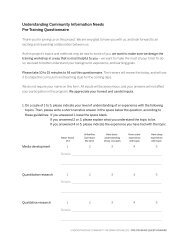STArTInG A LOCAL RADiO stAtiOn - Nai
STArTInG A LOCAL RADiO stAtiOn - Nai
STArTInG A LOCAL RADiO stAtiOn - Nai
- No tags were found...
Create successful ePaper yourself
Turn your PDF publications into a flip-book with our unique Google optimized e-Paper software.
Section 6: Financial management3. Marketing StrategyYour marketing strategy builds partnerships with businesses and organizations that are willing topay for airtime to advertise on your station. But remember that clients will place advertisements onlyif they believe that the station has enough listeners.A good marketing strategy considers these four areas:nnnnPricing – How much should your radio station charge for airtime? Should for-profit (commercial)and non-profit organizations pay the same rate? Will you offer discounts to clients that signmulti-month advertising contracts? How much do your competitors charge?Promotion – The goal of any promotion is to attract listeners. Promotions also show potentialadvertising clients how your station can inform local people about their products, services ordevelopment projects. Radio stations use two types of promotions: “on air” and “off air”. On airpromotions are most common; they can include contests or a series of radio spots that highlightyour station’s ability to reach local people. Off air promotions include visits to potential clients byradio station staff/volunteers who describe the benefits of advertising on your station. Printedmaterials such as stickers, posters, brochures and business cards always should be available anddistributed widely in your community.Products – What products does your radio station offer potential clients? Advertising airtimecan be sold in different forms. These include jingles, program sponsorships, or call-in shows withprizes donated by clients. Be creative!Place – Where do clients purchase advertising time? Should they visit the station? Or will a radiostation staff member/volunteer visit the client?What’s the difference between marketing and sales?Marketing and sales work together to build the station’s sustainability. Marketing informs thepublic, including audiences and advertisers, about the station’s mission, its programming and services.Strong marketing must be an everyday activity shared by many staff and volunteers, and it costs money.Marketing prepares the ground for sales. The more listeners a station has, the more it can charge for salesof advertising products. Potential clients who know about the station and listen to its programs are morelikely to become advertisers.Sales are one of the station’s main sources of money. The station sends full-time staff members to meetwith clients (advertisers), bring back signed contracts, and then collect the money according to thedue dates in client contracts. Station managers also may encounter potential clients and should alwaysencourage them to meet with the station’s sales representatives. Sales people are paid a small salaryplus a commission (percentage) based on the amount of money (revenue) they collect for the station.Sales people work best when their commission is stated in a transparent, written agreement, and whenthe commission percentage is same for all sales representatives. Sales people also work best when theirincome is not limited; the more money they bring into the station, the higher their total commissions.SOURCES OF REVENUERevenue (all categories of money coming into the station) is generated from a mix of sources. A stationshould not rely on any one source of money, whether that is advertising or another type of funding. A70 STARTING A <strong>LOCAL</strong> RADIO STATION: A MANUAL FOR AFGHANISTAN
















